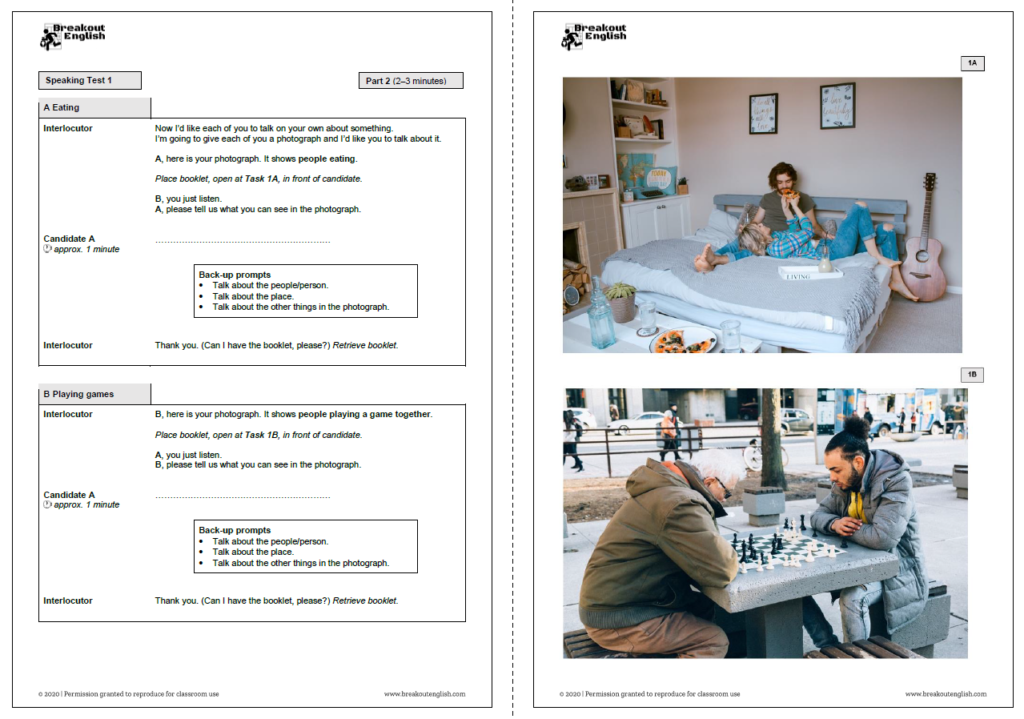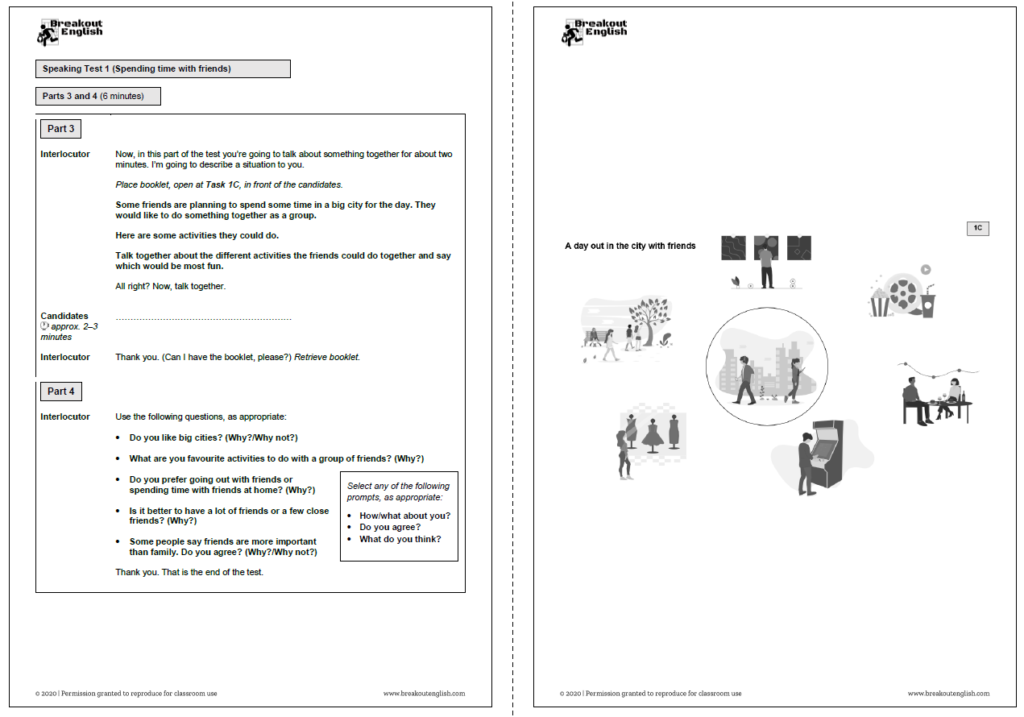
Speaking at B1 level involves candidates showing that they are able to communicate effectively in everyday situations. You won’t be asked to explain scientific details or economic concepts, but you will need to be prepared to talk about common topics such as family, friends, work, travel or your social life.
To help you prepare, we’ve designed 5 complete Preliminary (PET) Speaking tests in Cambridge style booklets just like you would see on exam day. These can be used in the classroom or at home. All the exams are in the updated 2020 format.
GET PRELIMINARY (PET) SPEAKING TESTS:
GET ALL CAMBRIDGE SPEAKING TESTS (PET, FCE, CAE):

Contents
Format of Preliminary (PET) Speaking
Part 1 – Interview
In Preliminary (PET) Speaking Part 1, you will be asked a couple of personal questions. This interview is individual and lasts for 2-3 minutes. The examiner will always ask your name and where you are from. Then, they will ask a personal question or two about a common topic like your hobbies. Answers should be extended beyond a couple of words, but don’t need to be too long. Remember, this is the first time the examiners will hear you speak, so make a good impression!
For more typical Speaking Part 1 questions, check our Cambridge Speaking Part 1 post.

Part 2 – Long Turn
Part 2 of the Preliminary PET Speaking exam is also individual. You have to describe a picture in detail for about a minute. The important thing here is to organise your ideas using linking words (and, but, so, however, also etc.) It’s also a chance to show off your vocabulary knowledge. Talk about all the different details in the picture using the best language you know.
The topics for this part of the exam are normally related to everyday activities and the pictures always include people doing things. For more details about PET Speaking Part 2 and a plan of how to speak for a minute, check our post about Describing a Picture.

Part 3 – Collaborative Task
In Part 3, you will be speaking with your partner. The examiner will give you a set of pictures and describe a situation to you. You then need to discuss the options in the pictures with your partner for 2-3 minutes. You can talk about which ideas are good or bad before making a decision about the best option.
Interaction between you and you partner is essential in PET Speaking Part 3. The examiners want to see you asking questions and having a real conversation with your partner. Don’t worry if you don’t talk about all the different pictures. They are there to give you ideas and encourage discussion.

Part 4 – Discussion
In the discussion stage of Preliminary (PET) Speaking, you will be asked a series of questions by the examiner. These questions are always based on the same topic as in the previous stage. For example, if you discussed different travel options in Part 3, the discussion in Part 4 will also be about travel. Sometimes the examiner will ask you a question directly in this part of the exam, but they may also encourage you to talk together with your partner.
The questions in PET Speaking Part 4 can be more difficult than the previous parts of the exam and you don’t have them written down. Listen carefully and, if necessary, ask the examiner to repeat.

Tips and Tricks for Preliminary (PET) Speaking
- Relax and try to focus on the individual parts of the exam. If one part is difficult, you can always improve later on.
- Be careful with basic vocabulary and grammar. Mistakes with simple language can cost you points.
- Include some complex language while you are speaking. If you can use conditionals, relative clauses or passive, you might get extra points.
- Don’t forget to interact with the examiner and your partner.
- Very short answers are bad! Always extend your answers with words like and, but, so, because etc.
- If you don’t know a word, think about something different to say. It is natural to forget vocabulary, but you don’t want to lose time.
- Stay positive and friendly. A personal touch makes a big difference to the impression that you give the examiners.
Get Preliminary PET Speaking Sample Tests
Breakout English offers 5 complete Preliminary PET Speaking tests. The sample tests are designed to be as close as possible to the same style, format and level as the real exam in order to get the best practice possible.
GET ALL CAMBRIDGE SPEAKING TESTS (PET, FCE, CAE):
Get all 3 levels of Breakout English’s Cambridge Speaking tests and save compared to buying individually.


Proceeds from paid materials go towards helping Breakout English continue to offer the majority of our quality materials 100% free and accessible to teachers and learners of English. Thank you for your support!


Thank you so much for sharing
You’re welcome Hasina!